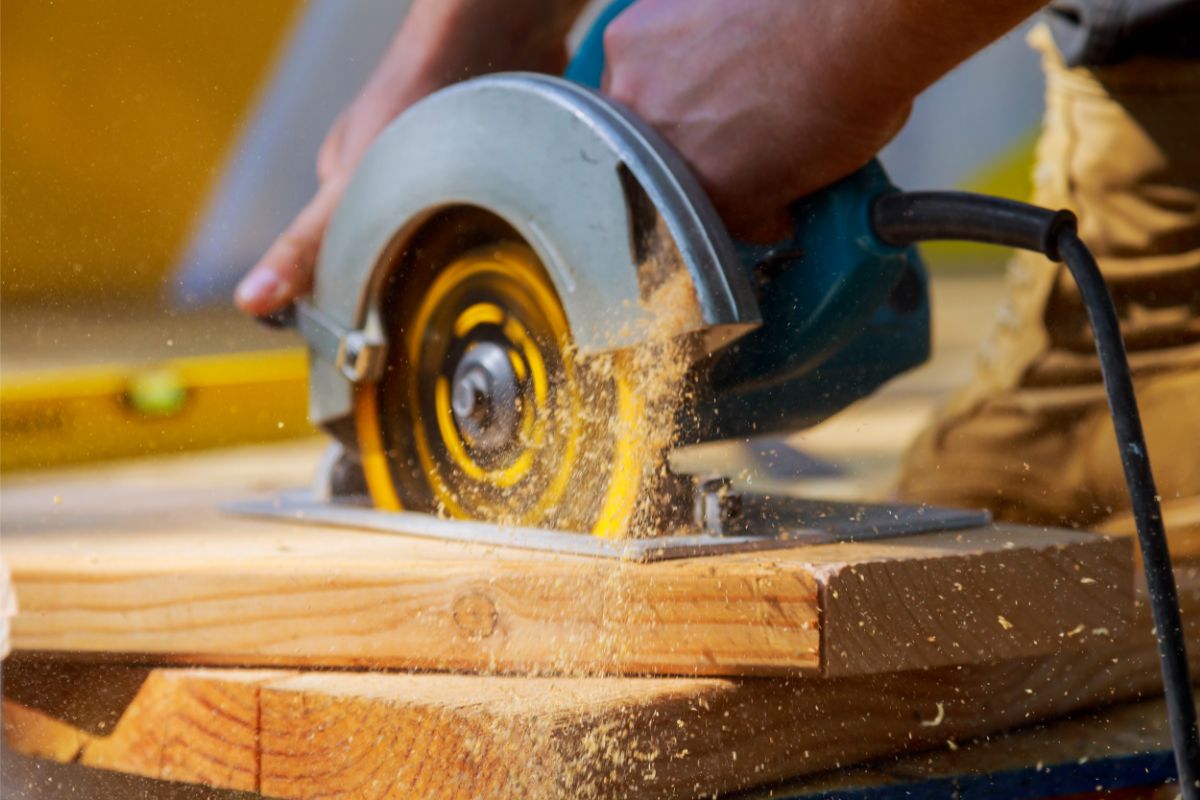Contents
Using any form of power tool can be a messy process, especially when working with wood, but none more so than a circular saw, which can create a large quantity of sawdust in no time at all.
Luckily, there are several ways to manage and collect the sawdust created when using a circular saw, ensuring your workspace remains tidy, and you don’t have to waste your time cleaning up after yourself.
How Is Sawdust Created?
Sawdust is a waste byproduct of woodworking, created during sawing, sanding, milling, planing, and routing, and can be created when the specific tool you are using bores into the wood and creates fragments/chippings.
When working on wood, the lignified wood cells are shattered by the intensity of the metal tools, and break out whole cells, and groups of cells, from the piece of wood.
This shattering of wood cells creates dust, while breaking out whole cells, or groups of cells, creates the chips – the larger pieces of wood fragments.
How To Manage & Collect Sawdust
Luckily, there are many ways that sawdust can be managed and contained before it makes a mess around the workspace.

Dust Bags
One method is to attach a dust bag over the end where the sawdust and wood chippings are expelled from the saw.
While this is not always safe or possible, depending on the saw, in most cases it can be a great way to manage the amount of mess made during the use of a circular saw, and can be a good way of not only keeping the air clean, but also ensuring the continued safety of the workspace.
Saw Hoods
These customized hoods are designed to cover up the saw blade, and can contain the sawdust and wood chippings to either the floor or the workbench you are working at.
While perhaps less effective than the above method, it does have the benefit of adding extra safety (by covering the top of the blade), and containing the mess to only one part of the space you are working in.
Dust Sheets
Something else you could do is lay down dust sheets around the area you are going to be working in.
These will catch most of the dust – although there are always stray ones – and provide the benefit of simply folding up the sheet at the end of the session, and depositing the sawdust into the trash.
What Are The Benefits Of Tidy Workspaces?
There are many benefits to taking control of the sawdust situation and keeping the workspace clean and tidy.
Health
While inhaling the sawdust might not do you any particular harm in the short term, continual daily inhalation of foreign materials won’t do you any good.
In this sense, it is a good idea to not only wear a face mask to minimize the amount of dust you are inhaling, but also to employ one of the methods mentioned above to control the amount of residual dust that is present in the workspace.
In the long term, wood dust has been shown to be a carcinogen in humans, and has been proven through human epidemiology to increase the risk of nasal cancers – which includes the nasal cavities themselves, as well as the paranasal sinuses.
Breathing in wood dust has also been shown to cause a rise in allergy symptoms, some of them severe in nature.
This is especially harmful for people who already suffer with bad allergies, and in extreme cases could cause them to develop respiratory problems as a result.
As well as breathing in foreign material, there is also the potential for it to get lodged in the eyes, the ears, and the nose – all of which could prove bad for your health, particularly with larger fragments that could be sharp or jagged.
Safety
Sawdust can also be a safety concern, with the most dangerous aspect being just how flammable the substance can be.
While most wood is a naturally flammable material, it is even more flammable in the form of dust and woodchips.
Accumulations of sawdust can create a ready source of fuel in the event that a fire strikes, and particles in the air also have the potential to ignite or even cause explosions under extreme circumstances.
These dust explosions can be fairly commonplace in industrial settings, and occur when flammable dust particles become suspended in the air inside an enclosed environment.
For dust explosions to occur, there has to be five distinct factors in play at any one time. These include:
- A combustible dust present in the air.
- A high concentration of dust particles dispersed in the air.
- The presence of an oxidant (like pure oxygen).
- An ignition source – like a lighter or sparks.
- A confined space.
If all of these things are in play, the chance of a dust explosion is very high indeed, and can range from being moderately harmful to being deadly, depending on the concentration of dust, and the type of particles being generated.
Wood dust is the most common cause, due in part to its high combustibility of the substance.
The Environment
Saw mills and other industrial areas where large quantities of wood are being processed can be harmful to the environment.
This is because of wood particles entering drainage areas and being transported into natural reservoirs and bodies of water, causing damage to wildlife and habitats.
While this is not a concern for a personal venture in your own home, it still shows the importance of managing sawdust collections on an industrial scale.
Final Thoughts
And there we have it, everything you need to know about sawdust, and the best ways to collect and manage it within your workspace.
It is clear to see that sawdust can pose a greater threat than previously perceived, and just how important it is to properly manage it.






